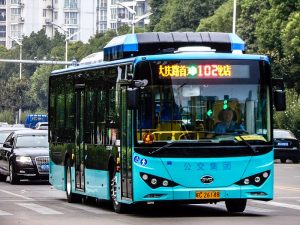Growing public knowledge about the relationship among climate, pollution, and personal consumption has led to a rapid rise in demand for green transportation options — including electrified public transit, like e-buses.
However, despite the growth in demand, few global cities have begun adding electric vehicles (EVs) to their public transportation fleets. The places that have are primarily located in the Asia-Pacific. Asia is leading the world when it comes to EVs in public transport and that may change the global approach to transit.
The electric bus market has grown rapidly over the past few years and is expected to reach more than 900,000 units by 2027. The growth is being driven primarily by municipal purchases throughout Asia-Pacific, especially in China. The Chinese government is subsidizing EV adoption as regional and municipal markets move to modernize their transit systems with new EVs.
In addition to being one of the biggest markets for EVs and e-buses, China has seen several other public EV firsts as well. For example, the city of Shenzhen recently became the first to fully electrify its fleet of municipal vehicles.
While China is driving much of the trend, the growth of EV public transportation is also happening throughout Asia-Pacific.
Jakarta, home of the world’s largest bus system, has begun testing electric buses as a possible option to reduce pollution generated by public transit.
In Pakistan’s capital, Islamabad, the government is preparing the deployment of the city’s first fleet of electric buses. The nation’s government hopes that EVs powered by renewable energy will be cheaper to operate than traditional vehicles and reduce the country’s dependence on oil.
In all of these examples — but especially Shenzhen, where the number of electric buses added has been one of the largest — the adoption of EVs has had a few different effects.
New e-buses require the creation of advanced EV infrastructure — more than 40,000 charging stations in the case of Shenzhen — which may help cities provide much-needed private charging infrastructure. This is one of the biggest limits on further EV adoption right now.
The e-bus purchases and overall growth of the market have also driven cheaper and more efficient battery technology. These will both be key if electric vehicles are adopted in major cities around the world.
The rapid adoption of e-buses is also providing a testing grounds for new EV technology. Shortly, publicly-owned EVs may be experimentally powered by technology like self-charging batteries before it becomes available to general consumers.
Public demand for electrified transportation will likely continue to grow — especially as knowledge about pollution and climate change improves and EV technology becomes more robust. Innovations from the Asia-Pacific will probably be necessary if other major cities hope to add e-buses to their public transit fleets.
Jenna Tsui is a technology and sustainability journalist located in Texas. She co-owns The Byte Beat blog and writes for sites like Blue & Green Tomorrow, Green Journal, and Triple Pundit. Check out her work on TBB or follow her on Twitter @jenna_tsui

































